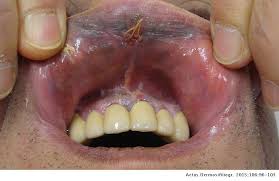 Mucosal melanoma is a rare subtype of melanoma approximately .8 to 3.7% of all melanomas in Caucasians.
Mucosal melanoma is a rare subtype of melanoma approximately .8 to 3.7% of all melanomas in Caucasians.
MM can arise from any mucosal epithelium: lower G.I. tract (26.5%), nasal cavity, paranasal sinuses (23%), gynecological sites (22.5%), oral cavity (15%), urologic sites (5%) upper G.I. tract (5%), and conjunctiva (3%).
While cutaneous melanoma incidence has increased, the incidence of MM has remained stable.
MM is one of the most aggressive subtypes of melanomas and has a significant worse prognosis than cutaneous melanoma: five year overall survival rate of 14%.
MM tends to present in older populations compared to cutaneous melanomas, 70 years versus 55 years.
MM has an incidence two times higher in females, largely to the development of the disease in the genital tract.
The incidence is higher in Caucasians than other racial groups.
Caucasians have the highest proportion of genitourinary MM while Asian/Pacific islanders most commonly have anal rectal MM.
Head and neck MM tumors are most frequently seen in Hispanics.
The etiology of MM is unknown.
Sun exposure is not a risk factor for MM.
Patients are likely to present with symptoms and more advanced disease compared with patient with cutaneous melanomas.
Complete surgical excision is the primary treatment for MM, however there are anatomic and multifocal pattern of growth Bentley difficult.
Even with negative margins local recurrence is common as are distant metastases.
Radiotherapy after surgery has improved locoregional control but not survival.
There is an overall reduced response rate to checkpoint inhibitors for mucosal melanoma compared with cutaneous melanoma.
